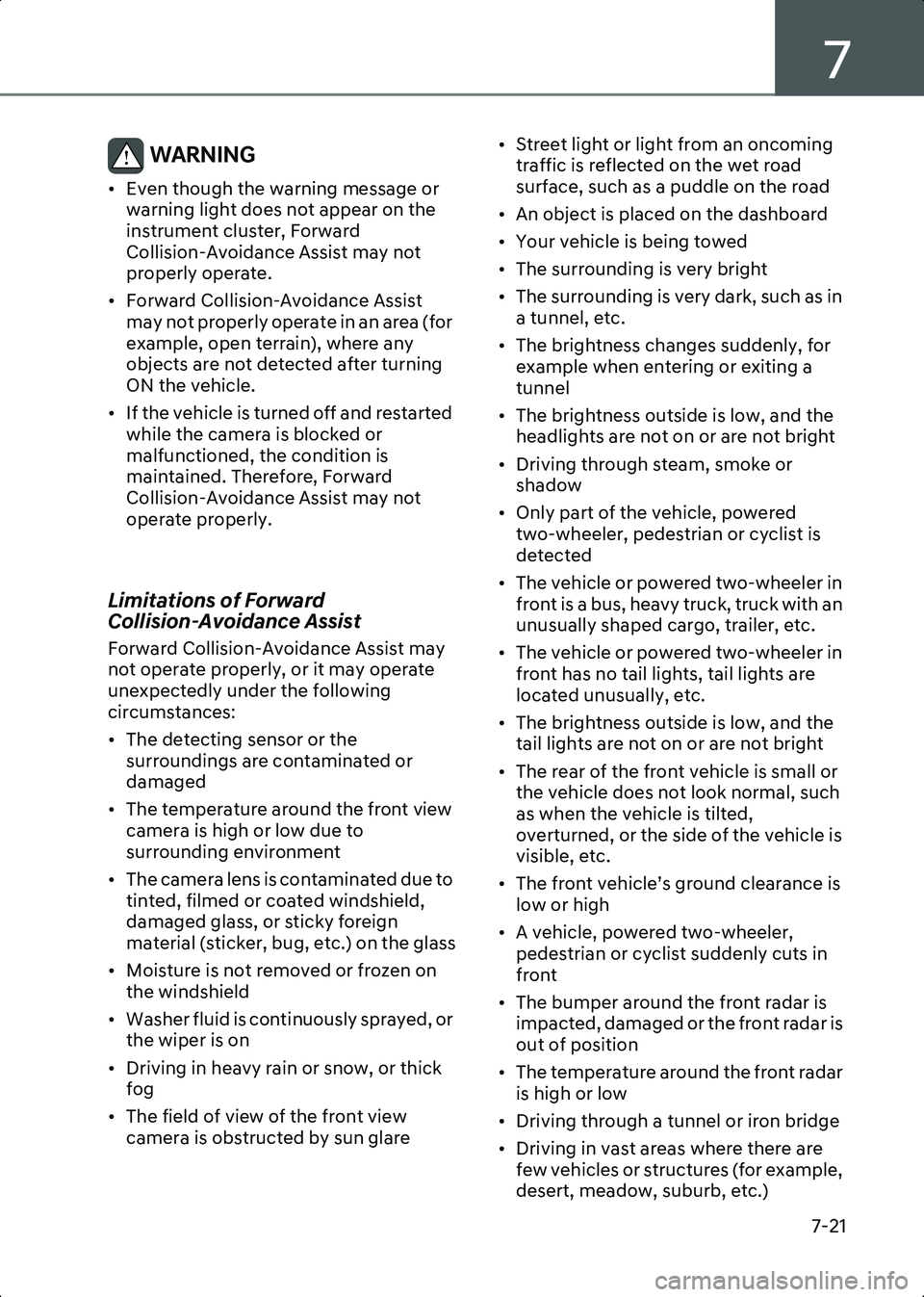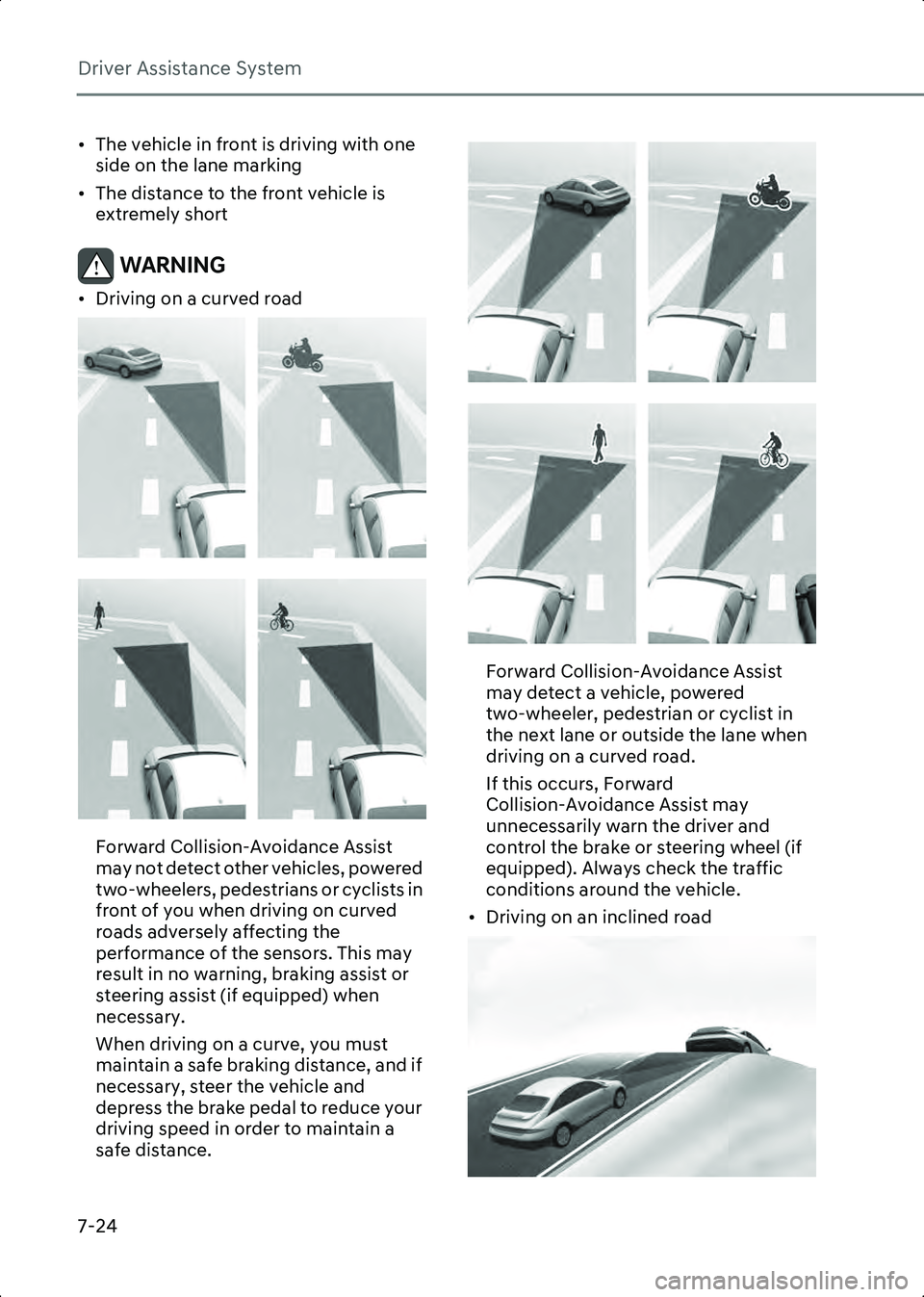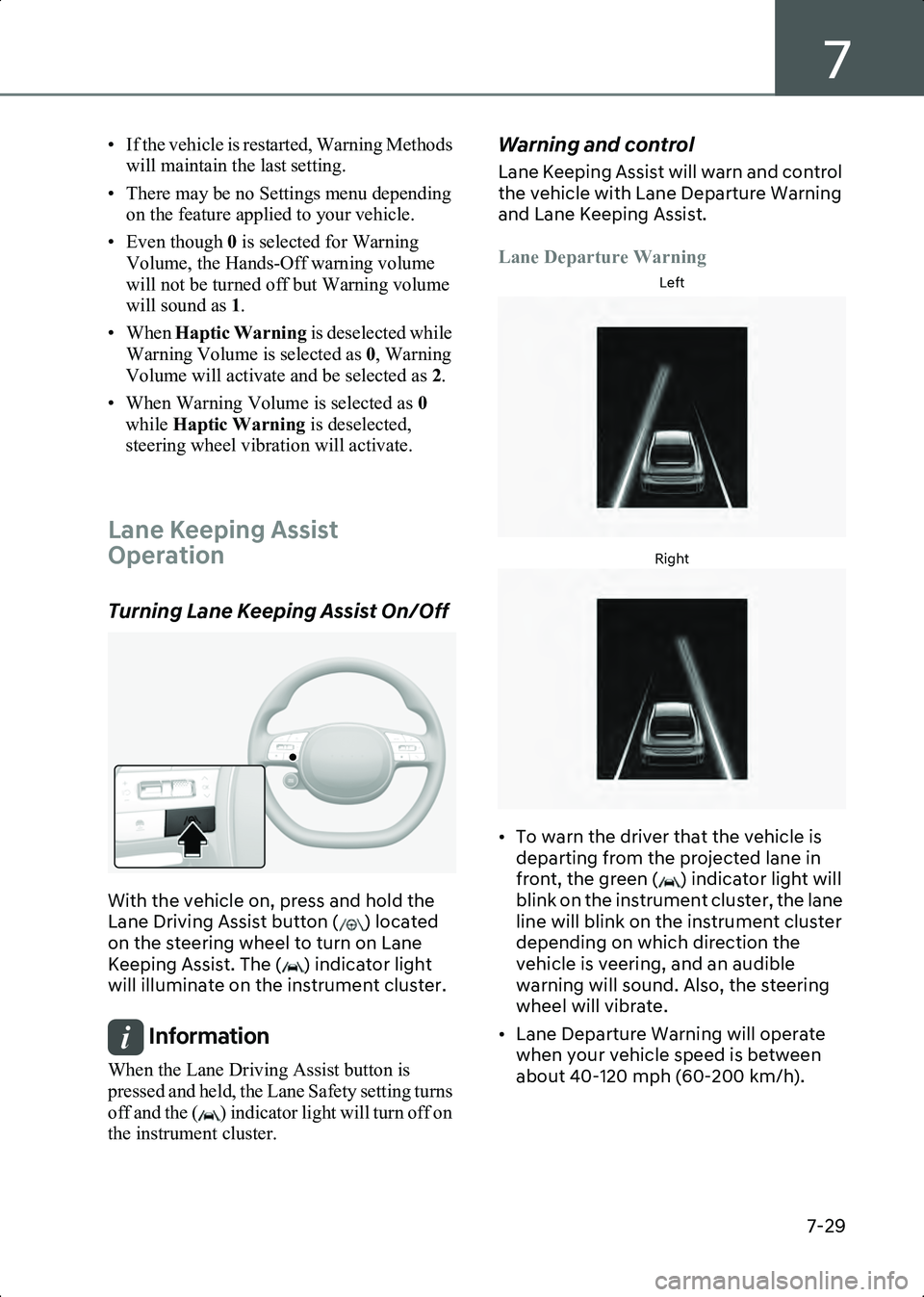2023 HYUNDAI IONIQ 6 wheel
[x] Cancel search: wheelPage 365 of 582

7
7-21
WARNING • Even though the warning message or warning light does not appear on the
instrument cluster, Forward
Collision-Avoidance Assist may not
properly operate.
• Forward Collision-Avoidance Assist may not properly operate in an area (for
example, open terrain), where any
objects are not detected after turning
ON the vehicle.
• If the vehicle is turned off and restarted while the camera is blocked or
malfunctioned, the condition is
maintained. Therefore, Forward
Collision-Avoidance Assist may not
operate properly.
Limitations of Forward
Collision-Avoidance Assist
Forward Collision-Avoidance Assist may
not operate properly, or it may operate
unexpectedly under the following
circumstances:
• The detecting sensor or the surroundings are contaminated or
damaged
• The temperature around the front view camera is high or low due to
surrounding environment
• The camera lens is contaminated due to tinted, filmed or coated windshield,
damaged glass, or sticky foreign
material (sticker, bug, etc.) on the glass
• Moisture is not removed or frozen on the windshield
• Washer fluid is continuously sprayed, or the wiper is on
• Driving in heavy rain or snow, or thick fog
• The field of view of the front view camera is obstructed by sun glare • Street light or light from an oncoming
traffic is reflected on the wet road
surface, such as a puddle on the road
• An object is placed on the dashboard
• Your vehicle is being towed
• The surrounding is very bright
• The surrounding is very dark, such as in a tunnel, etc.
• The brightness changes suddenly, for example when entering or exiting a
tunnel
• The brightness outside is low, and the headlights are not on or are not bright
• Driving through steam, smoke or shadow
• Only part of the vehicle, powered two-wheeler, pedestrian or cyclist is
detected
• The vehicle or powered two-wheeler in front is a bus, heavy truck, truck with an
unusually shaped cargo, trailer, etc.
• The vehicle or powered two-wheeler in front has no tail lights, tail lights are
located unusually, etc.
• The brightness outside is low, and the tail lights are not on or are not bright
• The rear of the front vehicle is small or the vehicle does not look normal, such
as when the vehicle is tilted,
overturned, or the side of the vehicle is
visible, etc.
• The front vehicle’s ground clearance is low or high
• A vehicle, powered two-wheeler, pedestrian or cyclist suddenly cuts in
front
• The bumper around the front radar is impacted, damaged or the front radar is
out of position
• The temperature around the front radar is high or low
• Driving through a tunnel or iron bridge
• Driving in vast areas where there are few vehicles or structures (for example,
desert, meadow, suburb, etc.)
Hyundai_CE_en_US.book Page 21
Page 366 of 582

Driver Assistance System
7-22
• Driving near areas containing metal substances, such as a construction
zone, railroad, etc.
• A material is near that reflects very well on the front radar, such as a guardrail,
nearby vehicle, etc.
• The cyclist in front is on a bicycle made of material that does not reflect on the
front radar
• The vehicle or powered two-wheeler in front is detected late
• The vehicle or powered two-wheeler in front is suddenly blocked by an
obstacle
• The vehicle or powered two-wheeler in front suddenly changes lane or
suddenly reduces speed
• The vehicle or powered two-wheeler in front is bent out of shape
• The vehicle in front is covered with snow
• You are departing or returning to the lane
• Unstable driving
• You are on a roundabout and the vehicle or powered two-wheeler in
front is not detected
• You are continuously driving in a circle
• The vehicle in front has an unusual shape
• The vehicle in front is driving uphill or downhill
• The pedestrian or cyclist is not fully detected, for example, if the pedestrian
is leaning over or is not fully walking
upright
• The pedestrian or cyclist is wearing clothing or equipment that makes it
difficult to detect
B7000403
The illustration above shows the image
the front view camera and front radar
are capable of detecting as a vehicle,
pedestrian and cyclist.
• The pedestrian or cyclist in front is moving very quickly
• The pedestrian or cyclist in front is short or is posing a low posture
• The pedestrian or cyclist in front has impaired mobility
• The pedestrian or cyclist in front is moving intersected with the driving
direction
• There is a group of pedestrians, cyclists or a large crowd in front
• The pedestrian or cyclist is wearing clothing that easily blends into the
background, making it difficult to
detect
• The pedestrian or cyclist is difficult to distinguish from the similarly shaped
structure in the surroundings
• You are driving by a pedestrian, cyclist, traffic signs, structures, etc., near the
intersection
• Driving in a parking lot
• Driving through a tollbooth, construction area, unpaved road,
partial paved road, uneven road, speed
bumps, etc.
• Driving on an incline road, curved road, etc.
• Driving through a roadside with trees or streetlights
Hyundai_CE_en_US.book Page 22
Page 368 of 582

Driver Assistance System
7-24
• The vehicle in front is driving with one side on the lane marking
• The distance to the front vehicle is extremely short
WARNING • Driving on a curved road
B7000404
B7000405
Forward Collision-Avoidance Assist
may not detect other vehicles, powered
two-wheelers, pedestrians or cyclists in
front of you when driving on curved
roads adversely affecting the
performance of the sensors. This may
result in no warning, braking assist or
steering assist (if equipped) when
necessary.
When driving on a curve, you must
maintain a safe braking distance, and if
necessary, steer the vehicle and
depress the brake pedal to reduce your
driving speed in order to maintain a
safe distance.
B7000406
B7000407
Forward Collision-Avoidance Assist
may detect a vehicle, powered
two-wheeler, pedestrian or cyclist in
the next lane or outside the lane when
driving on a curved road.
If this occurs, Forward
Collision-Avoidance Assist may
unnecessarily warn the driver and
control the brake or steering wheel (if
equipped). Always check the traffic
conditions around the vehicle.
• Driving on an inclined road
B7000408
Hyundai_CE_en_US.book Page 24
Page 369 of 582

7
7-25
B7000409
B7000410
B7000411
Forward Collision-Avoidance Assist
may not detect other vehicles, powered
two-wheelers, pedestrians or cyclists in
front of you while driving uphill or
downhill, adversely affecting the
performance of the sensors.
This may result in unnecessary warning,
braking assist or steering assist (if
equipped) or no warning, braking assist or steering assist (if equipped) when
necessary.
Also, vehicle speed may rapidly
decrease when a vehicle, powered
two-wheeler, pedestrian or cyclist
ahead is suddenly detected.
Always have your eyes on the road
while driving uphill or downhill and if
necessary, steer your vehicle and
depress the brake pedal to reduce your
driving speed in order to maintain a
safe distance.
• Changing lanesB7000412
[A] Your vehicle
[B] Lane changing vehicle
When a vehicle moves into your lane
from an adjacent lane, it cannot be
detected by the sensor until it is in the
sensor's detection range. Forward
Collision-Avoidance Assist may not
immediately detect the vehicle when
the vehicle changes lanes abruptly. In
this case, you must maintain a safe
braking distance, and if necessary,
steer your vehicle and depress the
Hyundai_CE_en_US.book Page 25
Page 370 of 582
![HYUNDAI IONIQ 6 2023 Owners Manual Driver Assistance System
7-26
brake pedal to reduce your driving
speed in order to maintain a safe
distance.
B7000413
[A] Your vehicle
[B] Lane changing vehicle
[C] Same lane vehicle
When a vehicle HYUNDAI IONIQ 6 2023 Owners Manual Driver Assistance System
7-26
brake pedal to reduce your driving
speed in order to maintain a safe
distance.
B7000413
[A] Your vehicle
[B] Lane changing vehicle
[C] Same lane vehicle
When a vehicle](/manual-img/35/58885/w960_58885-369.png)
Driver Assistance System
7-26
brake pedal to reduce your driving
speed in order to maintain a safe
distance.
B7000413
[A] Your vehicle
[B] Lane changing vehicle
[C] Same lane vehicle
When a vehicle in front of you merges
out of the lane, Forward
Collision-Avoidance Assist may not
immediately detect the vehicle that is
now in front of you. In this case, you
must maintain a safe braking distance,
and if necessary, steer your vehicle and
depress the brake pedal to reduce your
driving speed in order to maintain a
safe distance.• Detecting vehicle
B7000414
If the vehicle in front of you has cargo
that extends rearward from the cab, or
when the vehicle in front of you has
higher ground clearance, additional
special attention is required. Forward
Collision-Avoidance Assist may not be
able to detect the cargo extending from
the vehicle. In these instances, you
must maintain a safe braking distance
from the rearmost object, and if
necessary, steer your vehicle and
depress the brake pedal to reduce your
driving speed in order to maintain
distance.
WARNING • When you are towing a trailer or another vehicle, turn off Forward
Collision-Avoidance Assist for safety
reasons.
• Forward Collision-Avoidance Assist may operate if objects that are similar
in shape or characteristics to vehicles,
powered two-wheelers, pedestrians
and cyclists are detected.
• Forward Collision-Avoidance Assist does not operate on bicycles, or smaller
wheeled objects, such as luggage bags,
shopping carts, or strollers.
• Forward Collision-Avoidance Assist may not operate properly if interfered
by strong electromagnetic waves.
Hyundai_CE_en_US.book Page 26
Page 372 of 582

Driver Assistance System
7-28
Lane Keeping Assist Settings
Lane Safety
B7001001
With the vehicle on, select Setup >
Vehicle > Driver Assistance > Driving
Safety > Lane Safety from the Settings
menu to set whether to use each
function.
If Lane Safety is selected, Lane Keeping
Assist will automatically assist the driver’s
steering when lane departure is detected
to help prevent the vehicle from moving
out of its lane. If Lane Safety is
deselected, Lane keeping Assist will turn
off and the ( ) indicator light will turn off
on the instrument cluster.
WARNING • Lane Keeping Assist does not control the steering wheel when the vehicle is
driven in the middle of the lane.
• The driver should always be aware of the surroundings. If Lane Safety is
deselected, Lane Keeping Assist cannot
assist you.
Warning Methods
B7000205_2
B7000205_3
With the vehicle on, go to Setup > Vehicle
> Driver Assistance > Warning Methods
from the Settings in the infotainment
system to select the following:
• Warning Volume : The Warning Volume
can be adjusted.
• Haptic Warning : The steering wheel
vibration can be set.
• Lane Safety Audible Warning Off : The
warning volume of Lane Safety does
not sound when Haptic Warning is
selected.
• Driving Safety Priority : Your vehicle
lowers all other audio volumes when
the Driver Assistance system warning
sounds.
Information • If you change the Warning Methods, Warning Methods of other Driver
Assistance systems may change.
Hyundai_CE_en_US.book Page 28
Page 373 of 582

7
7-29
• If the vehicle is restarted, Warning Methods will maintain the last setting.
• There may be no Settings menu depending on the feature applied to your vehicle.
• Even though 0 is selected for Warning
Volume, the Hands-Off warning volume
will not be turned off but Warning volume
will sound as 1.
• When Haptic Warning is deselected while
Warning Volume is selected as 0, Warning
Volume will activate and be selected as 2.
• When Warning Volume is selected as 0
while Haptic Warning is deselected,
steering wheel vibration will activate.
Lane Keeping Assist
Operation
Turning Lane Keeping Assist On/Off
B7001101
With the vehicle on, press and hold the
Lane Driving Assist button ( ) located
on the steering wheel to turn on Lane
Keeping Assist. The ( ) indicator light
will illuminate on the instrument cluster.
Information When the Lane Driving Assist button is
pressed and held, the Lane Safety setting turns
off and the ( ) indicator light will turn off on
the instrument cluster.
Warning and control
Lane Keeping Assist will warn and control
the vehicle with Lane Departure Warning
and Lane Keeping Assist.
Lane Departure Warning
Left
B7001102Right
B7001103
• To warn the driver that the vehicle is departing from the projected lane in
front, the green ( ) indicator light will
blink on the instrument cluster, the lane
line will blink on the instrument cluster
depending on which direction the
vehicle is veering, and an audible
warning will sound. Also, the steering
wheel will vibrate.
• Lane Departure Warning will operate when your vehicle speed is between
about 40-120 mph (60-200 km/h).
Hyundai_CE_en_US.book Page 29
Page 374 of 582

Driver Assistance System
7-30
Lane Keeping Assist
• To warn the driver that the vehicle is departing from the projected lane in
front, the green ( ) indicator light will
blink on the cluster, and the steering
wheel will make adjustments to keep
vehicle inside the lane.
• Lane Keeping Assist will operate when your vehicle speed is between about
40-120 mph (60-200 km/h).
Hands-off warning
B7001104
If the driver takes their hands off the
steering wheel for several seconds, the
'Keep hands on steering wheel' warning
message will appear on the instrument
cluster, and an audible warning will sound
in stages.
WARNING • The steering wheel may not be assisted if the steering wheel is held very tight or
the steering wheel is steered over a
certain degree.
• Lane Keeping Assist does not operate at all times. It is the responsibility of the
driver to safely steer the vehicle and to
maintain the vehicle in its lane.
• The hands-off warning message may appear late depending on road
conditions. Always have your hands on
the steering wheel while driving.
• If the steering wheel is held very lightly, the hands-off warning message may appear because Lane Keeping Assist
may not recognize that the driver has
their hands on the steering wheel.
• If you attach objects to the steering wheel, the hands-off warning may not
work properly.
Information • For more information on instrument cluster settings, refer to the “Cluster Display
Control” section in chapter 4.
• When lane markings (or road edges) are detected, the lane lines on the instrument
cluster will change from grey to white and
the green ( ) indicator light will
illuminate.
• When the lane markings (or road edges) are detected and Highway Lane Change Assist
is on, the lane lines on the instrument
cluster may change to green.
Lane undetected
B7001105Lane detected
B7001106
Hyundai_CE_en_US.book Page 30